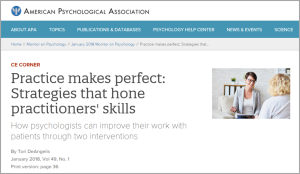The legendary cellist Pablo Casals was once interviewed by comedian George Carlin. When asked why, at age 93, he continued to practice three hours a day, Casals replied, “I’m beginning to show some improvement!”
Hard not to feel inspired and humbled by such dedication, eh? And while humorous, Casals was not joking. Across a wide variety of domains (e.g., sports, computer programming, teaching), deliberate practice leads to better results. Indeed, our recent study of mental health practitioners documented a growth in effectiveness consistent with performance improvements obtained by elite atheletes.
 The January 2018 issue of the APA monitor includes a detailed article on the subject. Staff writer Tori DeAngelis lays out the process of applying deliberate practice strategies to clinical work in clear, step-by-step terms. Best of all, it’s free–even continuing education credits are available if you need them.
The January 2018 issue of the APA monitor includes a detailed article on the subject. Staff writer Tori DeAngelis lays out the process of applying deliberate practice strategies to clinical work in clear, step-by-step terms. Best of all, it’s free–even continuing education credits are available if you need them.

